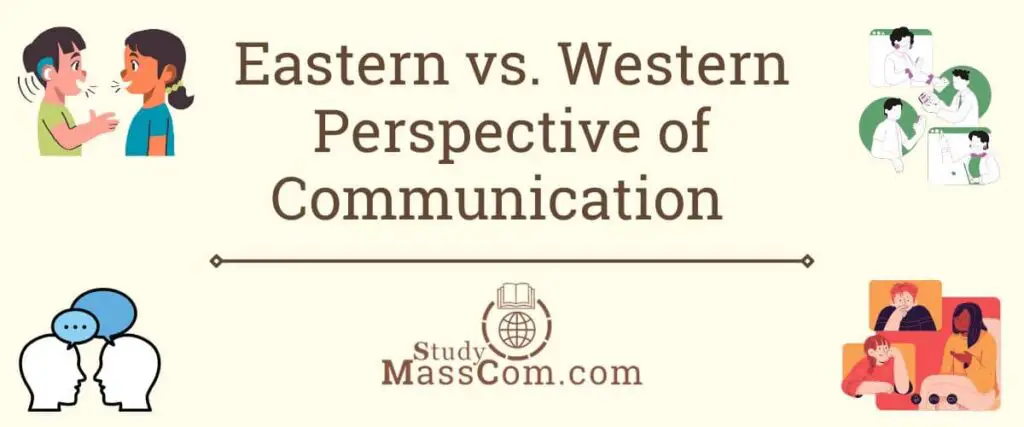Eastern vs. Western Perspective of Communication: A Comparative Study
Introduction
Communication is a fundamental aspect of human interaction, shaping relationships, conveying ideas, and fostering understanding. However, the way communication is perceived and approached can vary greatly across different cultures. In this article, we will explore the Eastern and Western perspectives of communication, shedding light on the underlying cultural differences that influence interpersonal exchanges.

Key Differences Between Eastern and Western Perspectives of Communication
Context and Directness
One of the primary distinctions between Eastern and Western communication lies in the emphasis placed on context and directness. In Eastern cultures, such as those found in East Asia, communication is often indirect and relies heavily on context, nonverbal cues, and implicit meanings. The avoidance of confrontation and preservation of harmony, are valued, leading to more subtle and indirect expressions. On the other hand, Western communication tends to be more direct, explicit, and focused on individual expression, with an emphasis on clarity and concise messages.
Hierarchy and Power Dynamics
Cultural perceptions of hierarchy and power dynamics also shape communication styles. In many Eastern cultures, such as those influenced by Confucian principles, hierarchical relationships and respect for authority are deeply ingrained. This is reflected in communication, where deference and politeness towards those of higher status or age are expected. In Western cultures, there is a greater emphasis on egalitarianism and individualism, resulting in a more informal communication style where people are encouraged to express their opinions freely, regardless of social or hierarchical standing.
Nonverbal Communication
Nonverbal communication plays a significant role in both Eastern and Western cultures, but the emphasis and interpretation of nonverbal cues can differ. In Eastern cultures, subtle facial expressions, gestures, and body language are carefully observed to decipher meaning beyond the words spoken. Silence is often valued, and pauses in conversation are considered important for reflection. In contrast, Western cultures tend to place more emphasis on verbal communication, with less attention given to nonverbal cues. Direct eye contact, firm handshakes, and expressive gestures are often seen as positive indicators of engagement and honesty.
Communication Styles
Communication styles in Eastern and Western cultures can also differ in terms of pacing, tone, and formality. Eastern cultures tend to value patience and a slower pace in conversation. Silence is often seen as an opportunity for reflection and is valued as a way to express respect or disagreement. Conversely, Western cultures generally prioritize efficiency and may exhibit a faster pace in conversation, valuing directness and assertiveness. The use of humor, sarcasm, and informal language can also be more prevalent in Western communication.
Individual vs Collective Orientation
The individualistic nature of Western cultures contrasts with the collectivist values often found in Eastern cultures. This difference impacts communication, as Westerners tend to focus on individual needs, preferences, and personal achievements. In contrast, Eastern communication emphasizes the group’s goals, maintaining harmony, and preserving the collective’s well-being. The emphasis on harmony and face-saving may lead to indirect communication and a reluctance to openly express disagreement in Eastern cultures.
Positive and Negative Aspects of Eastern Perception of Communication
Positive Aspects of Eastern Communication
| Harmony and Relationship Building | Eastern communication places a strong emphasis on maintaining harmony and fostering positive relationships. This focus on interpersonal connections can contribute to a supportive and cohesive social environment. |
| Respect and Politeness | Eastern communication often prioritizes respect and politeness, particularly towards elders, authority figures, and those of higher social status. This emphasis on courtesy helps create a sense of mutual respect and harmonious social order. |
| Nonverbal Communication Skills | Eastern cultures excel in nonverbal communication, such as reading subtle facial expressions, gestures, and tones of voice. This heightened awareness of nonverbal cues enhances understanding and facilitates effective communication, even in situations where direct verbal expression is limited. |
| Indirect Communication | The preference for indirect communication in Eastern cultures can be seen as a positive aspect. Indirectness allows individuals to express themselves tactfully and diplomatically, avoiding direct confrontation and potential conflicts. It also provides space for individuals to save face and maintain social harmony. |
Negative Aspects of Eastern Communication
| Lack of Directness | The emphasis on indirect communication in Eastern cultures can sometimes lead to misunderstandings, as messages may be implied rather than explicitly stated. This can create confusion and frustration, particularly in intercultural or business settings where directness is valued. |
| Difficulty Expressing Disagreement | The desire to maintain harmony and avoid conflict in Eastern communication can result in a reluctance to openly express disagreement or criticism. This can hinder the exchange of diverse opinions and impede the development of creative solutions. |
| High Context Communication | Eastern communication often relies on high-context communication, where meaning is derived from shared cultural knowledge and context. This can present challenges when communicating with individuals from different cultural backgrounds, as assumptions and shared understanding may not be readily apparent. |
| Pressure to Conform | In some Eastern cultures, conformity and group consensus are highly valued. This can create pressure on individuals to conform to societal expectations and suppress their individual viewpoints. This may limit individual expression and discourage independent thinking. It is important to note that these positive and negative aspects are generalizations and individual experiences within Eastern cultures can vary significantly. Additionally, what may be seen as positive or negative can also depend on the specific cultural context and personal perspectives. |
Positive and Negative Aspects of Western Perception of Communication
Positive Aspects of Western Communication
| Directness and Clarity | Western communication tends to be direct, explicit, and focused on clear and concise messages. This straightforward approach can facilitate efficient and effective communication, reducing the likelihood of misunderstandings. |
| Individual Expression and Assertiveness | Western communication tends to be direct, explicit and focused on clear and concise messages. This straightforward approach can facilitate efficient and effective communication, reducing the likelihood of misunderstandings. |
| Openness to Debate and Constructive Criticism | Western communication styles often encourage open debate and constructive criticism. Challenging ideas, questioning assumptions, and engaging in intellectual discourse are seen as positive ways to arrive at better solutions and deepen understanding. |
| Efficiency and Time Management | Western communication tends to prioritize efficiency and time management. Conversations are often structured and focused, with a goal-oriented approach. This can be beneficial in professional settings, allowing for productive exchanges and decision-making processes. |
Negative Aspects of Western Communication
| Lack of Context and Nonverbal Cues | Western communication tends to place less emphasis on nonverbal cues and contextual understanding compared to Eastern communication. This can lead to misinterpretations and misunderstandings, as important information and meaning may be lost in purely verbal exchanges. |
| Potential for Misinterpretation | The direct and assertive nature of Western communication can sometimes be perceived as confrontational or aggressive in cultures that prioritize indirectness and harmony. This can lead to unintended conflicts and strained relationships. |
| Dominance of Individualistic Perspectives | The focus on individual expression in Western communication can sometimes overshadow the importance of collective goals and community-oriented perspectives. This may hinder collaboration and cooperation in contexts where group consensus and harmony are valued. |
| Informality and Lack of Formality | While informality in Western communication can create a friendly and relaxed atmosphere, it may also lead to a lack of formality and professionalism in certain situations. This can be perceived as disrespectful or unprofessional in cultures that place a higher value on formalities and hierarchy. |
Eastern and Western Perspectives of Communication: Key Takeaways
Here’s a simplified chart highlighting some key differences between Eastern and Western communication:
| Aspect | Eastern Communication | Western Communication |
| Context | Relies heavily on context and implicit meanings | Emphasizes direct and explicit communication |
| Directness | Often indirect and subtle | Direct and straightforward |
| Hierarchy | Respect for authority and hierarchical relationships | Emphasis on egalitarianism and individualism |
| Nonverbal Communication | Nonverbal cues and silence are significant | Verbal communication takes precedence |
| Communication Styles | Slower pace, value silence for reflection | Faster pace, assertive, and efficient |
| Collectivism vs. Individualism | Emphasizes group harmony and collective goals | Focuses on individual expression and autonomy |
| Disagreement and Criticism | Tends to avoid direct disagreement and criticism | Encourages open debate and constructive criticism |
| Formality | Politeness and respect for formality | Relatively informal and casua |
Conclusion
Understanding and appreciating the Eastern and Western perceptions of communication is essential for effective cross-cultural interactions. While generalizations can oversimplify the complexity of individual experiences, recognizing these cultural differences can enhance empathy, reduce misunderstandings, and foster more meaningful connections. By embracing diverse communication styles, we can bridge cultural gaps and build stronger relationships in an increasingly interconnected world.
FAQs
Eastern Perception of Communication includes:
1. Contextual and Indirect: Eastern communication tends to be more context-dependent and relies on implicit cues. People may use nonverbal cues, such as body language and facial expressions, to convey meaning. Indirect communication is often preferred, where individuals may imply their thoughts or intentions rather than stating them explicitly.
2. Harmony and Face: Eastern cultures value maintaining harmony, avoiding conflict, and preserving interpersonal relationships. Face-saving is crucial, and individuals may avoid directly criticizing or disagreeing with others to save face and maintain harmony.
3. Silence and Listening: Silence is often regarded as a form of communication in Eastern cultures. People may use pauses and silence to convey respect, reflect on the conversation, or signify agreement. Listening skills are highly valued, and individuals may prioritize understanding others before expressing their own thoughts.
4. Hierarchy and Respect: Eastern cultures tend to have a stronger emphasis on hierarchy and respect for authority. Communication may be more formalized, with deference shown to older or higher-ranking individuals. Politeness, humility, and avoiding direct confrontation are considered important.
Western Perception of Communication includes:
1. Direct and Verbal: Western communication tends to be more direct and explicit. Individuals often express their thoughts, opinions, and intentions openly through verbal communication. Clarity and precision in speech are valued.
2. Individualism and Assertiveness: Western cultures often emphasize individualism, personal freedom, and independence. Expressing individual opinions and asserting oneself in communication is encouraged. Open debate and disagreement are more acceptable, as they are seen as a means to intellectual growth and problem-solving.
3. Efficiency and Time: Western communication often values efficiency and getting to the point quickly. Time is considered valuable, and there is often an expectation for communication to be concise and goal-oriented.
4. Equality and Informality: Western cultures tend to have a more egalitarian approach to communication, with less emphasis on hierarchical structures. Informality and casual conversation are common, and individuals may address others by their first names, regardless of their status or age.
The Eastern perception of communication is influenced by cultural values and traditions prevalent in Eastern cultures, which can vary across different countries and regions. However, there are some common characteristics associated with the Eastern perception of communication:
1. Contextual: Eastern communication tends to be highly contextual. It places significant importance on the surrounding circumstances, relationships, and nonverbal cues to understand the intended meaning. The context in which a message is conveyed is often considered crucial for understanding its full implications.
2. Indirect: Eastern communication often favors indirectness rather than directness. Instead of expressing thoughts or requests explicitly, individuals may rely on implication, suggestion, or subtle cues to convey their intentions. This indirect style of communication can be seen as a way to maintain harmony, save face, and avoid conflict.
3. Nonverbal Communication: Nonverbal cues, such as facial expressions, body language, and tone of voice, play a vital role in Eastern communication. These cues are often as important as verbal communication, if not more, in conveying meaning and understanding. Silence and pauses are also considered meaningful and can be used to express respect or signify agreement.
4. Hierarchy and Respect: Eastern cultures often place a strong emphasis on hierarchy and respect for authority. Communication is influenced by the social status and age of the individuals involved. Politeness, humility, and deference to authority figures are valued. Communication may be more formalized, with specific language and honorifics used to address others.
5. Group Harmony: Eastern cultures often prioritize maintaining group harmony and avoiding direct confrontation or disagreement. Preserving relationships and collective well-being are considered important. Conflict may be handled more indirectly, with a focus on finding compromises and maintaining a peaceful atmosphere.
In Eastern cultures, communication is often characterized by an emphasis on persuasion and eloquence. The use of persuasive language and eloquent speech is highly valued and considered important for effective communication. Here are some factors that contribute to this perception:
1. Historical Influence: Eastern cultures have rich literary traditions that have greatly influenced their perception of communication. In countries like China, Japan, and India, ancient texts and philosophical traditions emphasize the art of persuasive communication and eloquent expression. This includes practices such as rhetoric, poetry, and storytelling, which are considered important tools for conveying ideas effectively.
2. Language and Symbolism: Eastern languages, such as Chinese, Japanese, and Sanskrit, have a long history of using symbols, metaphors, and poetic devices to convey complex meanings. The mastery of language and the ability to use metaphors and symbolism effectively are highly regarded. Skillful use of words, tones, and gestures to create a vivid and persuasive message is considered a valuable communication trait.
3. Cultural Values: In many Eastern cultures, the ability to persuade and influence others is seen as a desirable skill. The concept of “guanxi” in China or “wa” in Japan reflects the importance of building and maintaining social connections, often achieved through persuasive communication. Harmony and consensus-building are valued, and individuals are encouraged to use eloquence to articulate their views in a way that aligns with the collective interests.
4. Rituals and Ceremonies: Eastern cultures often have elaborate rituals, ceremonies, and formalities that require eloquent speech and persuasive communication. Examples include tea ceremonies, religious rituals, and formal greetings. These occasions demand a careful selection of words and a refined style of communication to convey respect, gratitude, and other desired sentiments.






